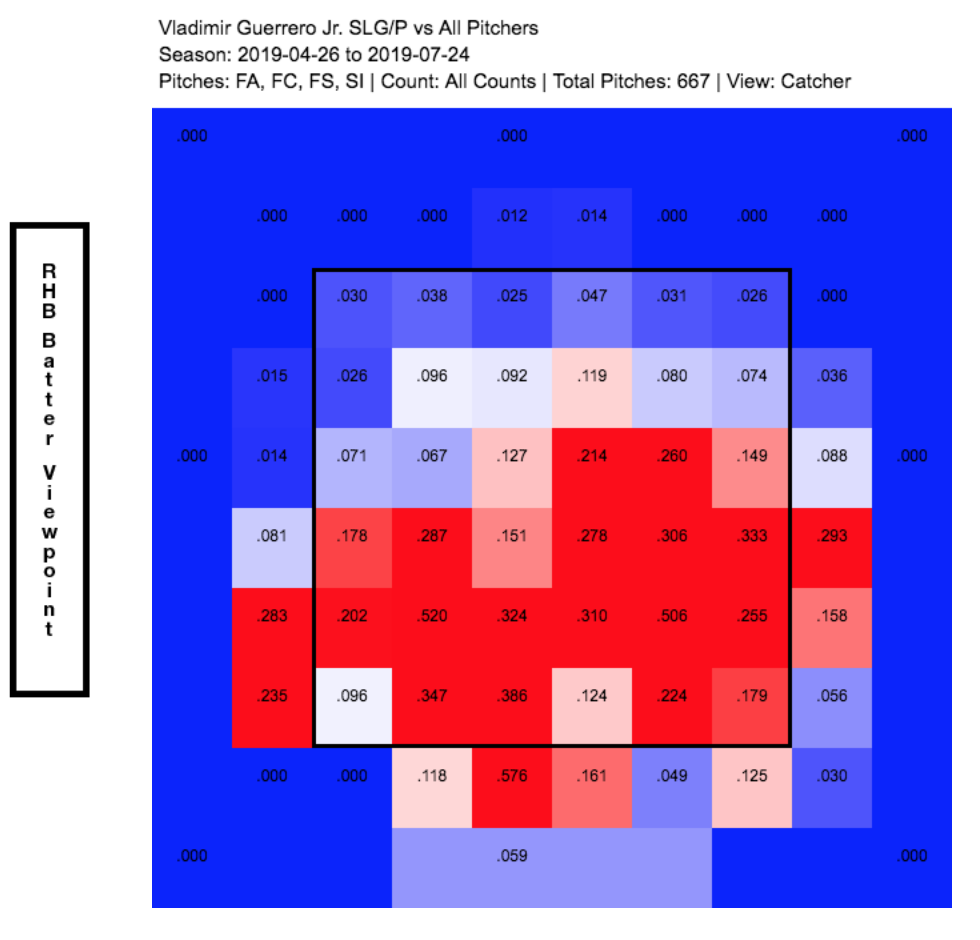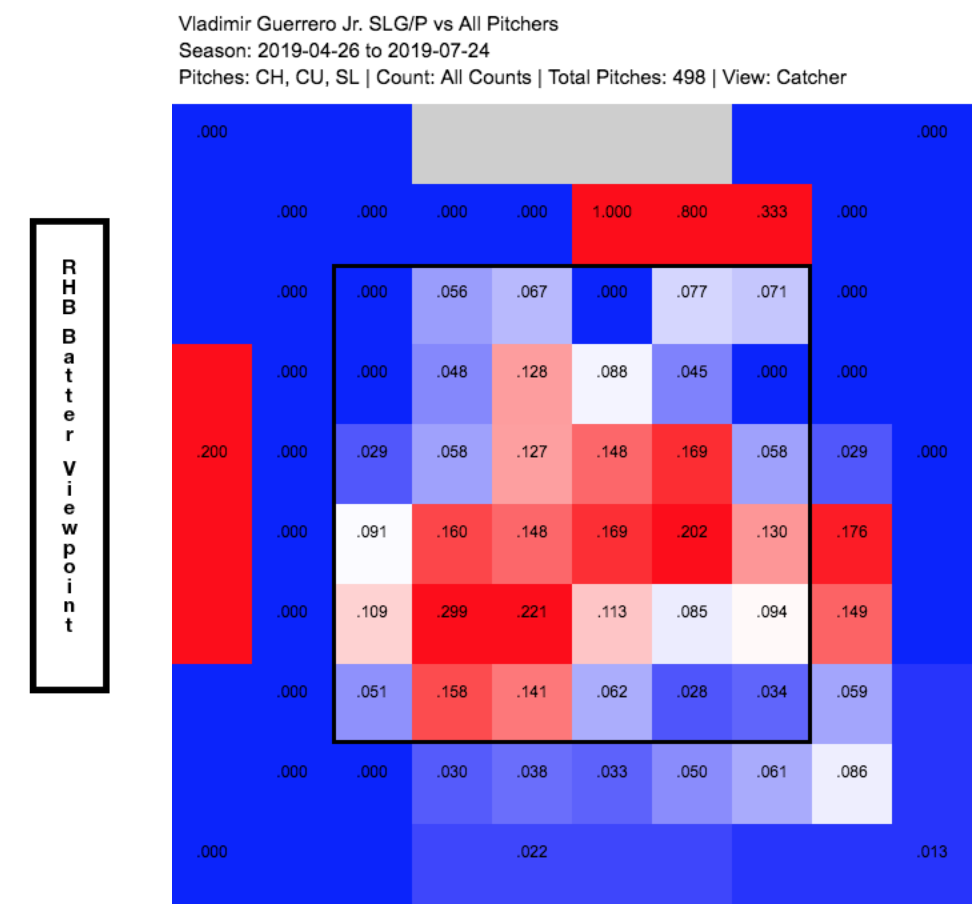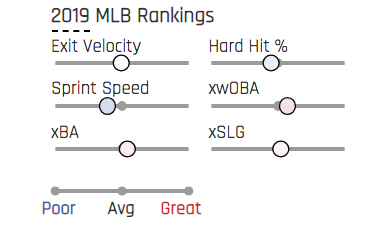One of the most fascinating stories of the 2019 season will almost assuredly be the relative disappointment that Blue Jays phenom Vladamir Guererro Jr. has been in his first taste of the big leagues. The hype that has surrounded the 20-year-old was universal, and he was largely viewed as the best prospect in at least a decade.
Back in the spring, scouts and sabermetric types alike drooled over the son of Hall of Famer Vladamir Guererro. Vlad’s raw abilities, specifically his 80-grade hit tool, amazed every scout, many sharing the cliche that the ball just sounded different off his bat. Respected projection systems and notoriously conservative ones, such as ZiPS, Steamer, and Derek Carty’s The Bat projected Guererro to immediately be among the top offensive players in baseball when he was called up despite having never seen a pitch in the majors—and even went as far as to project him to have either the highest or at least one of the highest batting averages in all of baseball. Simply put, Vladito was lauded as a can’t-miss player.
The funny thing about narratives is how quickly they can change. In just a few months since recovering from an oblique injury in spring training and making his debut in late April, suddenly Guererro is scuffling. In his first 70 big league games, Guerrero has generated only a measly 98 wRC+. He’s not hitting for average, he’s striking out far more than he did at any stop in the minors, and he’s not hitting for anywhere near the power he was expected to either, despite displaying his absurd ability to do so in the Home Run Derby earlier this month during the All-Star break.
His .254/.332/.407 triple slash comes with a mediocre .285 BABIP and .153 ISO. The 2019 league average is .253/.323/.434 with a .298 BABIP and .181 ISO.
He’s been a disappointment, and the savvy fantasy baseball player who has Guererro is unquestionably searching desperately for what changed. The long-term gleam is still strong, but is this just what Vlad is going to be for the remainder of 2019? In trade leagues, is he still worth trying to acquire?
A Look Under the Surface
Delving into the underlying numbers, there are contradicting signals seemingly being pointed at for Guererro. He’s hitting the ball on the ground 48.3% of the time, and while that typically helps batting average on balls in play, Guererro is unsurprisingly a below-average runner and therefore likely to have a tough time getting a high-BABIP even if he is hitting the ball hard.
His strikeout rate is by no means exorbitant, but after boasting one below 10% in the minors in 2018-2019 across all levels, the current 17.6% is worth noting. He’s still walking a respectable amount, just over 10% the time at 10.3%, but he’s putting up a pedestrian O-Swing% (the rate at which a hitter chases a pitch outside of the strike zone), with his 30.3% just under the average of 31.3%, and Z-Swing% (the rate at which he makes contact on a swing at a pitch in the zone), where he is marginally better with 71.0% vs. 68.5% average. He’s slightly under the league average in overall swinging-strike rate with a 9.9% vs. 11.1% average.
Checking into Guererro’s performance against specific pitches, it becomes a little more clear where he’s struggling. Per Fangraphs’ pitch values, he grades out positively when he gets a fastball, at 7.0 fastball runs above average, but performs negatively against most secondary types of pitches, with significantly poor numbers against sliders and curveballs, specifically at -7.1 slider runs below average and -5.4 curveball runs below average. He’s right around zero for every other type of pitch, which means he typically wins the at-bat when he gets a fastball but can be beaten by pitchers who are able to make quality pitches with their sliders or curveballs.
Here is Guererro’s heat map by slugging percentage this season when he gets a fastball, cutter, sinker, or splitter thrown to him:

And here is what it looks like when Guererro gets a slider, changeup, or curveball:

Basically, Guererro crushes fastballs in the bottom two-thirds of the zone and just in or out of it, especially ones over the heart of the plate, and does a respectable amount of damage to offspeed pitches if they are in the strike zone or right around it, but if he gets a secondary pitch outside of the strike zone he has not been able to do much with it.
Exit Velocity, Launch Angle Conundrum
The scouts weren’t wrong when they said that the ball sounded different off Guererro’s bat; he possesses an absolute elite ability to sting the ball, even as young as he is. Per Statcast, there have been 45 batted balls that came off the bat harder than 115 mph, and Guererro has been responsible for five of them, including being tied for the second-best overall at 118.9 mph.
It’s wildly impressive, but the outcomes from these five balls in play have to be frustrating for Guererro, as he is only 2-5 with two singles from them. That isn’t a typo; he hit balls at 115.1 mph, 115.5 mph, and 116.8 mph that ended up being outs. The two on which he did reach base, he didn’t even get extra bases.
There is a level of bad luck in those occurrences, but Guererro is not absolved from blame either. His launch angle on all five of them is under 6.5 degrees, and one of them was even -11.9%(?!) Let’s a look at the 116.8 mph bullet he hit here:
https://gfycat.com/informalcelebrateddolphin
It’s great that Guererro is able to pulverize baseballs, but it’s not hard to see why it is significantly less optimal if he is doing it on balls that barely get off the ground. In the era of the fly-ball revolution, Guererro drives the ball at or near the ground when he does get one he can damage. Remember, too, that his ground -ball rate is up at almost 50% at 47.7%, after all. Guererro also ranks right around average when it comes to Baseball Savant’s scoring, as he grades very closely to the middle of the league in average overall exit velocity, hard-hit rate, expected weighted on-base average, expected batting average, and expected slugging percentage. Guererro’s average launch angle of 6.9% is notably below the league average rate of 11.1.

Where Do We Go From Here?
One especially interesting thing when seeing that Guererro is in the middle of the pack with exit velocity and hard-hit rate is the idea that because we know he has hit so many balls hit extremely hard, he must also be hitting a higher amount of balls weakly than what would be anticipated. In some ways, it seems like a good thing if he has a chunk of weakly struck balls, as it would represent an easier challenge to overcome on getting them up in velocity than it would be if Guererro had a large number of moderately well-hit balls but needed to get his peak exit velocity higher.
The summation of the poor average launch angle and the moderately higher amount of weak contact weighing down his average exit velocity paint the picture of a hitter who would be what we expected with a couple of alterations in his swing and continued improvement in pitch recognition, especially against offspeed and breaking pitches.
On one hand, it is unquestionably better to be able to hit the ball hard and have to adjust the launch angle than to have to hit the ball harder with an already acceptable launch angle, but it still doesn’t mean Guererro can necessarily change it right now, especially not in the final two months of his very first season.
One thing that we do know is that he has the ability and retains the overall upside to make a change to his launch angle that could unlock significant improvement in his batted-ball numbers. Optimists can point to Guererro’s incredible performance in the Home Run Derby and say that it shows he is able to make an effort to drive the ball in the air (albeit on batting practice pitches) with the raw power he has shown he has, but it seems like a lot to expect somebody in his first taste of the big leagues to be able to turn that switch on and start hitting more fly balls.
It’s not bold in the slightest to say Guererro is going to improve from here on his current numbers, but his updated projection forecast is probably in line with what should be expected. If Guererro continues to demonstrate a good understanding of the strike zone and makes a marginal improvement to his launch angle, that is a win heading into the remainder of the season.
Mike Trout is on a course to potentially be the best player of all time, and he struggled mightily in his own first taste of the big leagues; any player is susceptible to initial struggles until he adjusts. At the end of the day, Guererro is still one of the most impressive prospects of the past decade, and if anyone can make these adjustments in-season, he is as good a bet as any. At the same time, it feels more likely that when he spends time in the winter preparing for 2020, he’ll be more likely to tinker and unlock his true potential.
He’s not going to be discounted in any serious keeper or dynasty leagues, but he’s somebody worth inquiring on in a redraft if his owner is impatiently suffering from prospect fatigue and interested in moving on to another shiny new toy.
(Photo by David Kirouac/Icon Sportswire)

Great article. 2 other points I think worth mentioning are 1) he’s still seeing the 3rd fewest pitches in the zone for all players with over 300 PA, indicating he’s getting extreme respect from pitchers and 2) his contact rate of 88% is still pretty elite. It seems like he’s displaying most of the skills people expected in terms of raw power, hit tool, and pitch recognition, and is getting very little to hit. He seems to be a few tweaks away from doing more with what he does get, whether it’s this year or 2020.
Hi Sam, thanks for reading! Both of those you added are strong points, and I think specifically that the impressive contact rate on pitches in the strike zone combined with his already fairly strong grasp for the strike zone makes him a prime candidate for a hot streak soon. No skill is especially “easy” to change, but I agree as well that I’d rather need him to tweak getting more balls in the air than needing to improve on exit velocity or on pitch selection – I think those both would be harder if even possible in-season.
It looks like your heatmaps is just the % of pitches in that particular zone, with red being the most common locations and not the areas where he is doing the most damage. perhaps a heat map of ISO or SLG would be better for what you are trying to illustrate.
Hi Ryan, thanks for reading! I see what you mean, I think I could have more clearly explained what I was trying to demonstrate there about the types of pitches and zones Vlad sees them in versus how he performs against each one as well. Thanks for the feedback!
Just a thought – maybe it’s a pitch recognition thing – violent natural swing, lots of O-swings with great eye-hand coordination and weak contact on unrecognized secondary pitches.